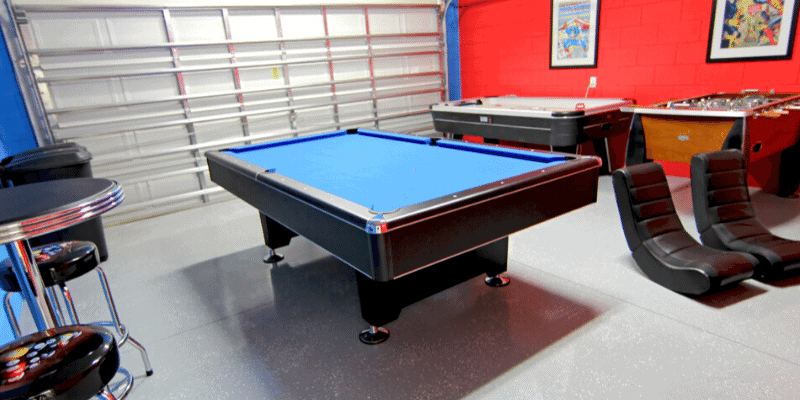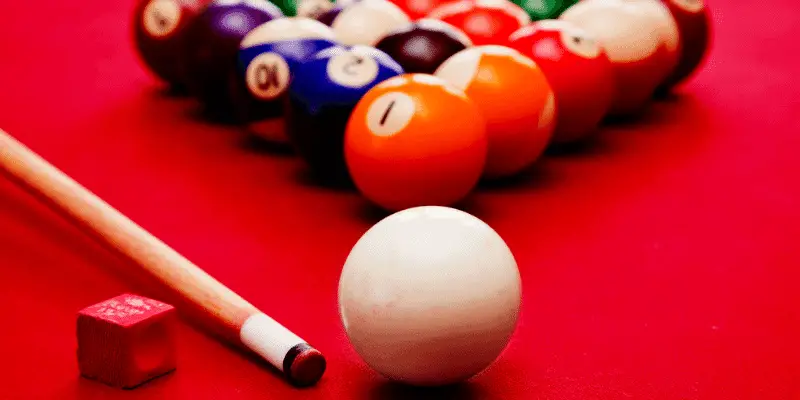Besides chess and poker, one of the most popular indoor games is a game of pool. At some point in our lives, all of us have indulged in this game or any other cue game.
One thing that leaves the pool players puzzled is the green color of the pool table.
Why are most pool tables green in color? Is there a symbolic reason behind the green color of a pool table? Similarly, why is the chalk always blue?
Let’s find out.
Why Are Pool Tables Green?
To find out the answer to the question, why pool tables are green, you need to know your history. The first thing that crosses your mind when you look at a pool table while a game is on is the striking resemblance it bears to a sports field.
Over here, your intuition is telling you the truth. If you go down in history, you will realize that pool, snooker, and other cue games are direct descendants of the lawn games that were played nearly 600 years ago.
The first-ever lawn game that resembled billiards was played back in the 1340s. At some point during the 15th Century, this game was brought indoor by King Louis XI of France. He is known as the first man on earth to have owned a pool table.
During the 17th century, billiard games started gaining popularity, not only in France but also in England and other parts of Europe.
Soon, billiard replaced its outdoor counterparts, and the outdoor version of the game became extinct. When the game was brought indoors, it was decided that the cloth will be green just to make it appear as if they were playing on grass.
As a result, the entire surface of the pool table was made green to make it resemble grass.
The tradition of using green color on a billiard table persists, even to this day.
This is the reason you find green felt in all cue games. Even the players that are new to cue games, because of the green color of the pool table are reminded of a grassy playing field.
Why are some Pool Tables Blue?
Up until now, we have discussed why most pool tables are green. But surprisingly, blue pool tables are just as popular. Pool tables that are blue can be seen in most professional snooker, pool, and Billiard Championships, which are aired on TV.

Why have blue pool tables, when the motive is to make the pool table resemble a grassy field? Does the blue pool table symbolize something different from what we play in our home and clubs?
The answer to this question also involves some history as well. It was in 1970 that the blue pool tables were first used in the US Open Pocket Billiard Championships.
The reason is that the green color of the pool table makes it hard for viewers to follow the balls on their television screen.
On the flip side, the blue pool table makes the balls appear more prominent. This is the reason, why pool tables in televised pool championships, were switched from green to blue color.
This allowed the viewers to enjoy pool games on their TV screens with much greater ease, and without any strain caused to the eye by green pool tables.
Even today, blue pool tables are used in televised pool championships, despite the modern television display which makes it easier for the viewers to follow the games, without any difficulty.
Because of their association with the national tournaments, blue pool tables have become the norm, and are even seen in private settings like clubs and households.
Blue Pool Chalk
Up until now, we have understood the reason why pool tables were green in the beginning and why we switched to blue color. However, one question that is frequently asked by pool players is about the blue color of chalk.
Nowadays, the usage of blue pool chalk has more to do with tradition. However, the roots of the blue pool chalk are still uncertain. Hang on tight, for school is in session.
The roots of the blue pool chalk are often attributed to a man named Jon Carr, who was the first person to make pool chalk. John Carr was a famous Billiards referee who made a fortune after coming up with his prized invention.
Carr’s cue chalks were introduced around the same time, the traditional wooden cues were replaced with the modern leather-tipped snooker sticks that are used today. At that time, some players would fill up their sticks to soften their willow.
Others would gently twist their pool sticks into the plastered walls of the Billiard halls, just to increase the friction. As a result, they found out that by dipping the tips of their cues into a powdery substance they could enhance the performance of their cues.
In the 1800s, a French military man named François Mingaud, came up with the idea of covering tips of the snooker cues with leather, which laid the foundation of the modern cues used today.
Despite improving the performance of the game, the innovation still failed to provide the game quality people were looking for.
Jack Carr was well aware of the early tips of dipping cue tips into the plaster. He realized that by chalking them, he could get the perfect hit from the cues invented by François Mingaud. By the 1820s, Carr started selling his blue cue chalk and referred to it as his magic twisting chalk.
The combination of leather tips with Carr’s blue chalk allowed players to get creative, and come up with new playing techniques. One of the best techniques, which are still used today, was to hit the side of the ball in a way that it created a spin.
The news of Carr’s magical invention spread like a forest fire and made him a fortune, much quicker than he had ever imagined.
However, Carr’s business came to a halt when people realized that his magic powder was nothing but blue chalk. Soon others started making the same product and started selling them under different brand names.
Do Pool Tables and Chalks Come In Other Colors?
Yes, pool tables and chalks come in a variety of different colors that are quickly growing in popularity.
These colors are even used by Hainsworth, which is the UK’s market leader in the pool table cloth. Hainsworth has been in business since the year 1783, and it manufactures the finest pool cloths of all colors that you can imagine.
Not long ago, Hainsworth produced a blue-colored pool cloth. The tone of blue used in this cloth resembles that of the cue chalk. Besides making blue and green pool cloths, Hainsworth makes red pool cloths as well.

Their red pool cloths come in a variety of tones. Some of the most common red tones by Hainsworth are bright red, burgundy red, Windsor red, and maroon.
Conclusion
We hope you got the answer to the question “why are pool tables green?” Remember, the color of every pool accessory out there has a little story attached to it.
If you are a pool enthusiast who wants to know more about a game of pool, get in touch with experienced players who have given their lives to this wonderful sport.
Not only will it add to your knowledge of this game’s history, but it will also enable you to become a better player yourself.
Other Pool Table/Game articles you may like:
- Pool Table Felt 101: A Guide To Difference Between Felt Types
- What Are Pool Table Balls Made Of?
- How to Replace Pool Table Pockets
- Can You Play Snooker on a Pool Table?
